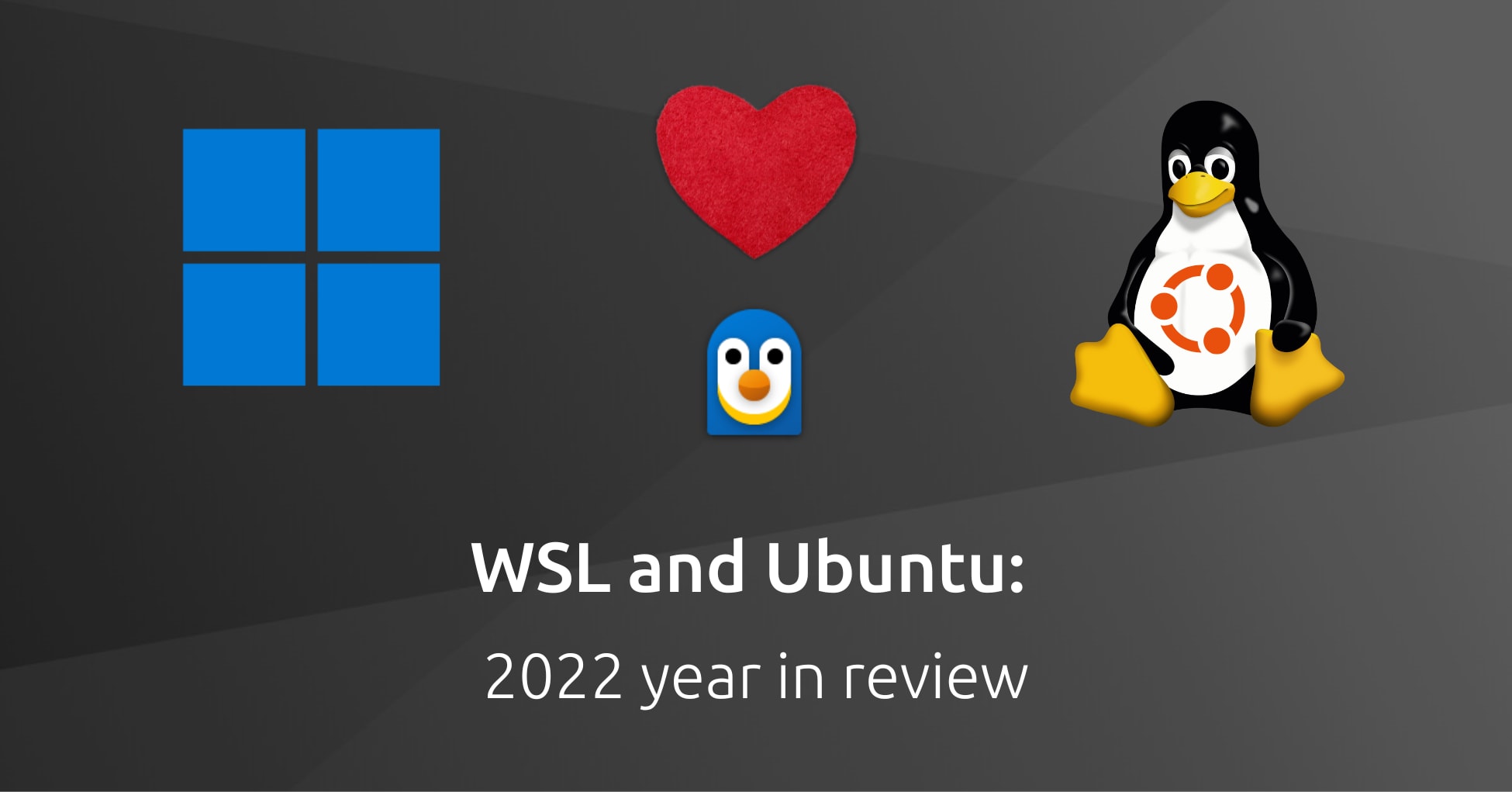Oliver Smith
on 4 January 2023
WSL and Ubuntu: 2022 year in review

In 2022, Windows Subsystem for Linux (WSL) exploded in popularity, with millions of users taking advantage of the ability to develop, create and administrate inside a native Linux environment deeply integrated with Windows.
This is thanks in large part to continued investment from Microsoft, consistently rolling out new features and updates for the platform on both Windows 10 and Windows 11. As the most popular distribution for WSL, the Ubuntu team is committed to supporting and building on these features to ensure that we deliver a polished and powerful Ubuntu WSL experience.
We’re looking forward to enhancing Ubuntu WSL in 2023 with new features for enterprise users and developers. But for now let’s take a look back at our 2022 highlights and round up all of the changes and updates that landed in the last 12 months!
To kick things off, check out Microsoft PM Craig Loewen’s Ubuntu Summit talk on the past, present and future of WSL.
April: Tools and Tutorials for Data Scientists
For Data Scientists and AI/ML engineers working in a Windows-centric institution, WSL provides them with access to the full suite of open source data science tools optimised for Linux, including PyTorch, Tensorflow and scikit-learn. Thanks to WSL’s integration with the host machine they can spin up Python notebook environments in Linux and develop with them in their Windows browser or VS Code. Linux distributions in WSL also have access to the machine’s GPU via native Windows drivers, meaning frameworks like NVIDIA CUDA can take full advantage of your hardware with minimal performance impact when running inside Linux on Windows.
We’ve put together a number of pieces looking at data science workflows in Ubuntu WSL, including our Webinar from April 2022, and the following whitepapers and tutorials.
- Webinar: Ubuntu on WSL: An FAQ for Data Scientists and Developers
- Whitepaper: Ubuntu WSL for Data Scientists
- Tutorial: Setting up NVIDIA Cuda with Ubuntu on WSL
- Blog: Upgrade your data science workflows with Ubuntu WSL
For more insight into other users of WSL, check out the Stack Overflow section later in this post.
May: Ubuntu Preview is released on the Windows Store

The default Ubuntu application on the Microsoft Store always provides the latest LTS release of Ubuntu after the first point release (for example Ubuntu 22.04.1 LTS and later). Previous Ubuntu LTSs are also available to install for users who want to remain on a particular release; these provide a stable development base for users, with over five years of Long Term Support.
Ubuntu Preview, launched in May 2022, now delivers the latest daily builds of Ubuntu to WSL users and offers a way for developers to experiment with the latest toolchains and features available in interim or upcoming Ubuntu releases. It is not designed for production development but for those happy to explore and report issues they encounter to help improve future releases of Ubuntu.
June: Stack Overflow developers love WSL

The Stack Overflow Developer Survey landed in June 2022 and showed that the percentage of developers using WSL as their primary operating system had seemingly grown by approximately five times since 2021, from 3% of professional developers to over 14% in 2022. This growth is hard to conclude definitively however, since 2022 shifted to a multiple choice answer framework for this category.

We did some digging into these numbers to try and figure out what kind of developers were really driving this success. When filtering responses to only include users who specified WSL as their primary operating system we saw a strong preference for web development, devops and cloud engineers. However this mirrored the overall distribution of developers who answered the survey.

The most interesting view was to look at the number of WSL users as a percentage of respondents in each category. This gave us a slightly different picture, with cloud and devops engineers now leading the pack, closely followed by security professionals and more administrative roles.

During the Ubuntu Summit talk at the top of this post, Craig mentioned use-cases from both Blizzard and Electronic Arts and it’s notable to see 20% of game developers taking advantage of the improved workflows that come with Linux and Windows interoperability.
In terms of tools it’s no surprise to see Docker used by the vast majority of WSL users thanks to its deep integration with Docker Desktop, followed by npm for Node.js web development.

September: Systemd Support
In September, a major piece of the puzzle to deliver a fully fledged Ubuntu experience landed in WSL with the arrival of official Systemd support. Systemd makes developing and working with service applications easier than ever and enables support for Snapd and Snap applications like LXD and MicroK8s out of the box.
This functionality is enabled by default in Ubuntu Preview and will become the default for our other Ubuntu applications later on this year. To enable it today, simply edit /etc/wsl.conf inside your Ubuntu WSL distribution and add the following lines:
[boot]
systemd=trueThen restart your instance!
For more tips on working with Systemd in WSL, check out the following links:
November: WSL at the Ubuntu Summit

The new Ubuntu Summit launched in November attracting hundreds of developers and community members from all over the world to share their work and ideas for the future.
WSL had a strong presence with the talk from Microsoft that opened this blog followed by a number of smaller workshops.
Long-time contributor Dani Llewellyn gave a whistlestop tour of her Linux journey that spanned the earliest days of snaps and WSL to the present.
Canonical developer Carlos Nihelton talked about the challenges and workarounds when building cross-platform Flutter applications for both Windows and Linux.
There was even a lightning talk about using WSL to resurrect old printers on Windows, for a detailed walkthrough on this topic check out the Open Printing blog.
November: WSL2 transitions to the Windows Store App on Windows 10
Over the past 18 months, the Windows 10 and Windows 11 implementations of WSL2 had diverged significantly. Windows 11, delivering WSL as a Windows Store application, was able to move more quickly and include additional features such as WSLg and Systemd support ahead of the Windows feature-based implementation in Windows 10.
That ended in November as Windows 10 finally migrated WSL2 to a Windows Store application, unifying the Windows 10 and 11 experience.
Now, regardless of your Windows version, you can install WSL via the Windows Store, or by running wsl --install in Powershell (or wsl --update if you want to upgrade an existing version).
With this change, new updates can be delivered more quickly to all Windows users, meaning the pace of progression for WSL is only going to increase going into 2023.
Keep in touch for the latest Ubuntu WSL news
As you can see, 2022 was a transformative year for WSL with the addition of key foundational features alongside a significant growth in developer adoption. In 2023 we’ll continue to publish informative content to help developers get the most out of Ubuntu WSL. In addition we’ll be focussing on enterprise features to help IT administrators securely enable Linux developers whilst remaining a part of their organisation’s existing Windows ecosystem.
We’ll close this blog with a final video from Edu Gomez Escandell with his recent introduction to numerical computation applications using WSL and some links on how to get started.
To stay up to date with news, tutorials and guides sign up to our newsletter using the form on the right!
Getting started:
- Tutorial: Install Ubuntu on WSL2
- Tutorial: Window and Ubuntu interoperability
- Tutorial: Working with VS Code on Ubuntu WSL
Find out more at Ubuntu.com/wsl



